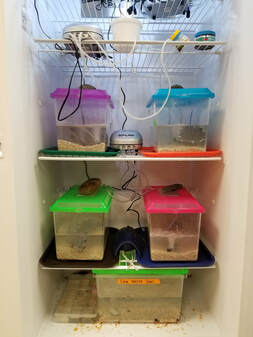The role of iron-oxidizing bacteria in contaminant mobility and sequestration

Iron is one of the most abundant metals on Earth and microbes have the ability to use it as an electron acceptor and electron donor to gain energy. Biologically produced iron oxides are highly reactive and may have a significant impact on the mobility and sequestration of heavy metals, wastewater runoff, and the other unwanted compounds. Therefore, iron-oxidizing bacteria can play a significant role in the fate of these contaminants in groundwater, coastal environments, and other natural systems. They may also be used in engineered treatment systems to remove or transform unwanted chemicals. Our research focuses on two specific unwanted contaminants: heavy metals and BTEX. By integrating microbial and geochemical analyses through comparative genomics, laboratory experiments with environmental isolates, and field studies we can begin to answer many critical questions about iron-oxidizers in the environment including:

- How do iron-oxidizing bacteria influence the fate of contaminants in the environment and vice versa?
- How do these microbes respond to sequestration of nutrients and heavy metals at a genetic level due to toxicity, fluctuating concentrations, and co-occurrence of multiple compounds?
- What influence do these interactions have on the fate of carbon, phosphorous, sulfur, and other important nutrients?
Life Attached: Microbial communities associated with stainless steel, shipwrecks, and other metal alloys
Microbial biofilms are common on steel structures where nutrients are often limiting, and attachment is an ecological advantage. The steel, often in the form of pipes and ships, can be a source of iron and carbon or can aid in the sequestration and concentration of these and other nutrients. Biofilms can produce concretions that protect these steel structures from chemical corrosion increasing their long-term integrity and stability as well directly contribute to biocorrosion and biofouling of these structures. Here, we aim to identify the microbial communities associated with stainless steel and a steel-hulled shipwreck along the Pamlico and Neuse River systems to determine how their differences may affect the integrity of these different iron-rich sources over time and which environmental conditions may control their presence. Recently, we had the opportunity to study the Pappy Lane Shipwreck (Rodanthe, NC) in collaboration with Dr. Nathan Richards, Director of the Maritime Studies Program at ECU, along with the Maritime Studies students who were working on identifying this culturally important wreck during their field course.
Photo Credit: John McCord Coastal Studies Institute
Crabs & Crobes: The role of microbes in aquatic host-parasite interactions

Microbes may be instrumental in host-parasite evolutionary and ecological dynamics because they evolve rapidly, allowing them to readily adapt to changing environmental conditions, including those that could influence arms races. The host-associated microbial community may provide protection from an invading parasite while the parasite-associated microbial community may aid in parasite virulence allowing the parasite to supersede host defenses. In fact, such microbial warfare in host-parasite encounters may be the true driver of co-evolutionary processes and a key feature in understanding how to predict and control disease. We are studying an aquatic crab Rhithropanopeus harrisii, (white-fingered mud crab) which is host to a castrating parasitic barnacle, Loxothylacus panopaei, in Southern and Southeastern USA. Through molecular analysis, the identification of mud crab and parasite microbiomes, and controlled laboratory experiments we aim to determine if microbial communities are pivotal in tipping the host-parasite balance in arms races, especially in a changing world.
Using environmental DNA to aid in biological conservation efforts of river herring
River herring are major prey for commercial and recreational fish species across the Atlantic region and are culturally important to coastal residents as a food source and a focus of social gatherings. However, coast-wide the stocks of river herring are in decline. The status of these spawning populations is difficult to assess due to the distance between watersheds and access points, narrow spawning season, and lack of funding. Environmental DNA (eDNA) survey techniques build on the premise that organisms are always shedding trace amounts of their DNA (think environmental forensics!). This method is faster and less labor-intensive than traditional surveys, making it feasible to sample more sites more often. Through cooperative field sampling efforts with state and federal agencies, citizen science efforts, and laboratory experiments to determine shedding and decay rates, we aim to develop a rapid, accurate quantitative method for assessing spawning populations of river herring. We are currently developing an eDNA repository of samples collected across the Atlantic. Check it out if you are interested in looking at eDNA of your organism of choice here!
Proudly powered by Weebly





